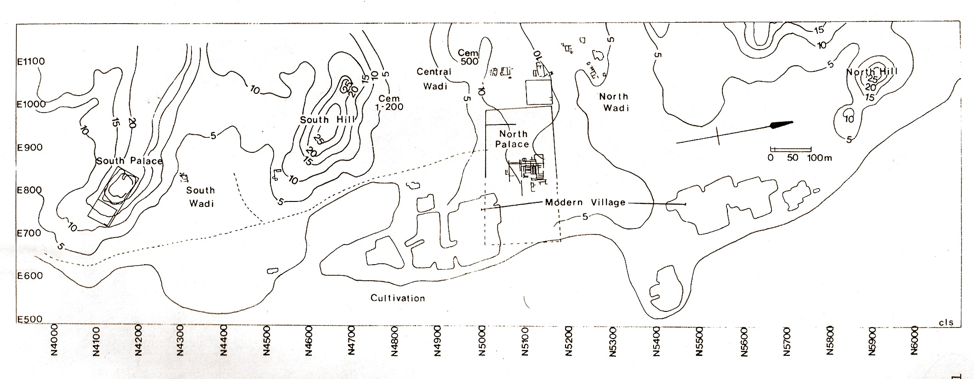
Probably one of the most important sites in Egyptian History and also one of the least well-known, Deir el-Ballas was the forward capital of the Theban kings during their drive to expel the Hyksos invaders in the north and reunite the land founding the glorious New Kingdom three thousand, five hundred years ago. Our fieldwork at Deir el-Ballas is critically important as the site is in danger of destruction by the neighboring modern community. The site was first excavated by George Andrew Reisner working for the Hearst Expedition of the University of California, Berkeley in the years 1900-1901, but never published and was long forgotten.
In order to clarify the records of the original expedition and enable the eventual publication of the site, four seasons of survey and clearance were undertaken in 1980, 1983, 1984, and 1986 by Peter Lacovara under the sponsorship of the American Research Center and the Museum of Fine Arts, Boston.
At the request of Mustafa Waziri, then Chief Inspector of the Antiquities of Qena, we went back to the site which was in danger from the expansion of the modern town. We began new fieldwork in 2017. The goals of the new work of the Ancient Egyptian Heritage and Archeology Fund at Deir e-Ballas are twofold, to publish Reisners’ original finds along with our new research at the site to both elucidate Reisner’s excavations and to protect and preserve the ancient monuments. Since it is also one of the few settlement sites to be extensively cleared, Deir el-Ballas also provides important insights into the daily life of the ancient Egyptians.
In many ways a precursor to Tell el-Amarna, the capital of Akhenaten and Nefertiti, Deir el-Ballas seems to have set the pattern for these royal cities of the New Kingdom. At the center of the site is a monumental structure known as the North Palace that must have served as the campaign palace for the Kings Seqenenre, Kamose, and Ahmose. Like the later royal cities, there is a series of houses, including large villas for the royal court, a workmen’s settlement with associated cult chapels, storage magazines, and cemeteries. At the southern end of the site is a massive watchtower known as the “South Palace,” which gives a commanding view of the Nile and the territory around it. It would seem to be from here that the Theban fleet was marshaled and sailed north to victory.
The fieldwork we are conducting will concentrate on ways to protect and restore this important Palace-City of the Theban kings. Our long-term goal is to coordinate our efforts with the Qena Antiquities Inspectorate and the Ministry of State for Antiquities to develop a strategy for the protection, conservation, and management of the site. The areas we will focus on in the upcoming seasons include work on the ‘South Palace’ to complete the recording of it through detailed photographs and plans and begin stabilization and restoration work on those areas recently damaged by vandalism and collapse by restoring the fallen brickwork, primarily on the eastern façade.
See the Report section for more information.
——————————————————————————————————————————-
تاريخ الموقع ووصفه
دير البلاص يعتبر واحد من أهم المواقع في التاريخ المصري وأيضًا واحد من أقل المواقع شهرة، قد كان العاصمة الأمامية
لملوك طيبة أثناء حملتهم لطرد الغزاة الهكسوس في الشمال وإعادة توحيد الأرض التي أسست الدولة الحديثة المجيدة قبل
ثلاثة آلاف وخمسمائة سنة. إن عملنا الميداني في دير البلاص له أهمية بالغة لأن الموقع معرض لخطر التدمير من قبل
المجتمع الحديث المجاور. تم التنقيب في الموقع لأول مرة بواسطة جورج أندرو ريزنر الذي كان يعمل في بعثة هيرست
بجامعة كاليفورنيا، بيركلي في الأعوام 1900-1901، ولكن لم يتم نشر بحثه مطلقًا وتم نسيانه لفترة طويلة.
تم إجراء أربعة مواسم من المسح والتطهير في الأعوام 1980 و1983 و1984 و1986 بواسطة بيتر لاكوفارا تحت
رعاية مركز الأبحاث الأمريكي ومتحف الآثار والفنون ببوسطن وذلك من أجل توضيح سجلات البعثة الأصلية وتمكين
نشر هذا الموقع في نهاية المطاف.
بناءً على طلب مصطفى وزيري، كبير مفتشي آثار قنا آنذاك، عدنا إلى الموقع الذي كان معرضًا للخطر بسبب توسع
المدينة الحديثة وبدأنا العمل الميداني لموسم جديد في عام 2017. اما عن أهداف صندوق التراث والآثار المصرية القديمة
في دير البلاص فهي ذات شقين وهما نشر اكتشافات ريزنر الأصلية جنبًا إلى جنب مع اكتشافاتنا الجديدة في الموقع وأيضا
لتوضيح حفريات ريزنر ولحماية الآثار القديمة والحفاظ عليها. وبما أنها أيضًا واحدة من مواقع الاستيطان القليلة التي تم
مسحها على نطاق واسع، فإن دير البلاص توفر معلومات مهمة عن الحياة اليومية للمصريين القدماء.
في كثير من النواحي، يبدو أن دير البلاص هو بداية مقدمة لتل العمارنة، عاصمة أخناتون ونفرتيتي، فبسببه قد حددت نمط
وتصميمه المدن الملكية في عصر الدولة الحديثة، فيوجد في وسط الموقع مبنى ضخم يعرف باسم القصر الشمالي والذي
كان بمثابة قصر الحملة للملوك سقنن رع وكامس وأحمس. بالمثل في المدن الملكية لاحقا، وهناك سلسلة من المنازل بما
في ذلك فيلات كبيرة للبلاط الملكي، ومستوطنة للعمال مع مصليات عبادة متصلة بها، واماكن تخزين، ومقابر. وفي
الطرف الجنوبي من الموقع يوجد برج مراقبة ضخم يعرف باسم “القصر الجنوبي”، والذي يوفر إطلالة رائعة على نهر
النيل والمنطقة المحيطة به ويبدو أنه من هنا تم تنظيم أسطول طيبة وأبحر شمالاً لتحقيق النصر.
هدفنا على المدى الطويل هو تنسيق جهودنا مع تفتيش آثار قنا ووزارة الآثار لوضع استراتيجية لحماية الموقع والحفاظ
عليه وإدارته وذلك عن طريق تركيز العمل الميداني الذي نقوم به في طرق حماية وترميم هذا القصر الذو اهمية لملوك
طيبة ان ذاك. وتشمل المناطق التي سنركز عليها في المواسم القادمة: “القصر الجنوبي” لاستكمال تسجيله من خلال
الصور والمخططات التفصيلية، والبدء في أعمال التثبيت والترميم في تلك المناطق التي تضررت مؤخرًا بسبب التخريب
والانهيار من خلال ترميم الطوب المتساقط في الواجهة الشرقية بالأخص.
لمزيد من المعلومات ارجع للقائمة الرئيسية.
